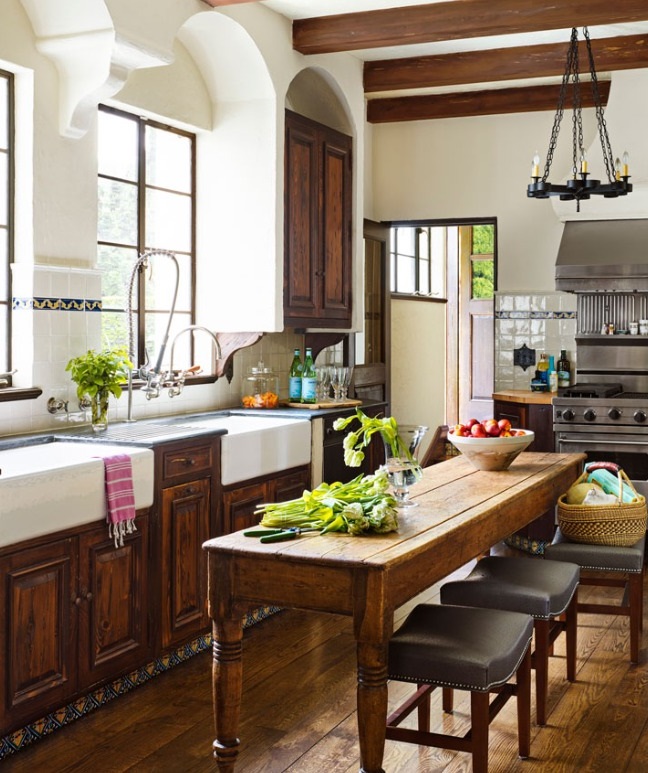Ah, the Mediterranean! Even die-hard Northern Lights fans and mountain lovers often succumb to the charm of this historic and diverse region. And some people want to take it into their own homes. The distinctive colors and shapes reflect lifestyle and maybe even invoke a little holiday happiness.
In addition, Mediterranean cuisine is trendy. This is not surprising because it often offers many delicious flavors and is healthy.
What could be more natural than realizing your passion for the Mediterranean in the kitchen – not only when cooking but also when preparing?
What material is the focus?
Suppose you want to furnish your kitchen in a Mediterranean style. In that case, you should first consider the suitable materials and where and how they can be combined. For small kitchens, it is generally recommended to use a lighter version so that the room does not look even smaller.
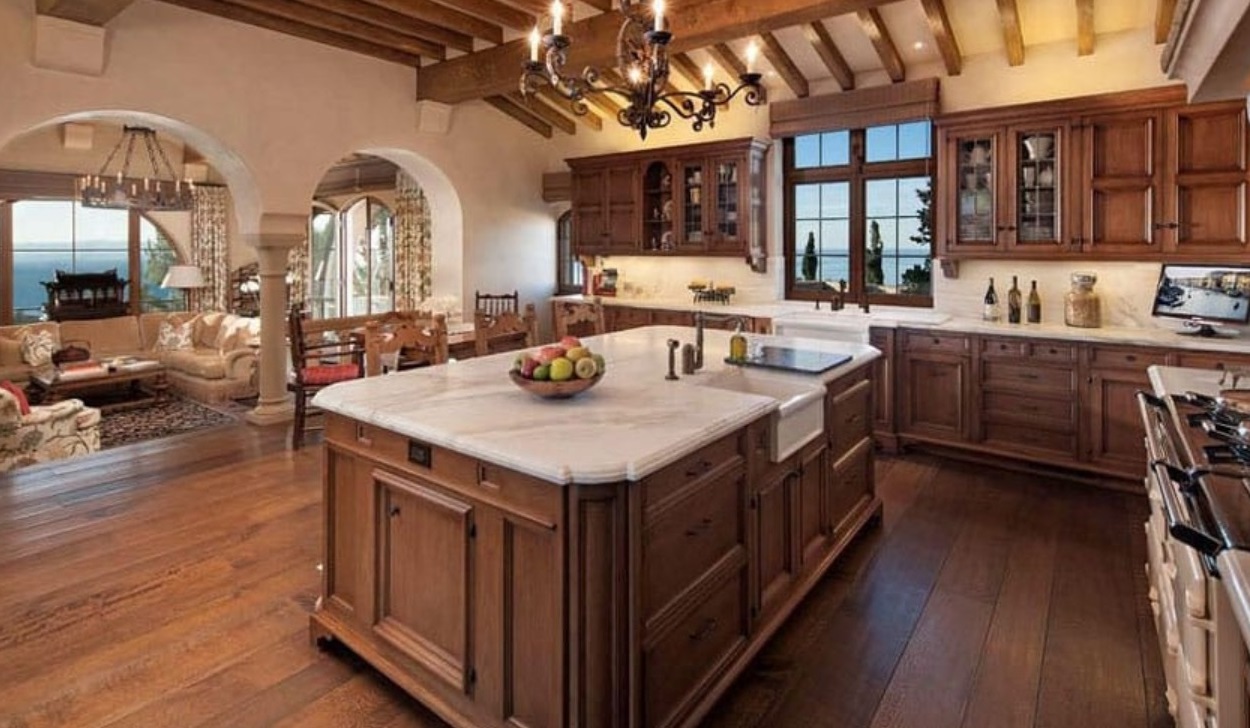
Anyone who has seen the Mediterranean appeal with their own eyes has probably noticed that natural materials are mainly used in the kitchen: stone, terracotta, and wood play a central role. When it comes to wood, the most important thing is the olive tree, which is everywhere. Pine and walnut wood are also typical. In contrast, terracotta is unglazed clay: vessels, art objects, and even tiles made from this material are everywhere.
If you prefer something more elegant, consider marble, quarried in many Mediterranean places. For furniture, rattan or metal are the right choices.
Color and shape
Anyone who has seen the special features of Mediterranean kitchens knows that they are usually furnished. The furnishings, in turn, often have an antique touch reminiscent of the classical era of Greece and Rome. If antiques are too ornate for you, you can also mix them in your kitchen here and there with modern country house-style furniture and accessories.
It is also essential to choose a color mix that suits your style. Classic Mediterranean kitchens usually have light or even white walls, and various splashes of color (for example, mosaics) provide visual highlights. However, accessories such as plates, towels, and flower vases are also available here to add color.

In general, earthy and calm colors dominate Italian-influenced styles. Different variations of ocher are often found, from yellow to orange and red to brown. This color is often the basic color of the house, both outside and inside.
You can arrange accents with green and blue shades. Traditionally, for example, window and door frames are painted. Blue means sea, and green means undulating landscapes, mainly in Italy and elsewhere. If both are too cool for you, red accents work too.
Tuscany and other local variants
You can divide the Mediterranean furnishing style into many different subcategories. This region is very diverse.
Tuscan style, in particular, is a more rustic variant that can make a room very interesting. Compared to Mallorcan furnishings, the Tuscan style largely avoids colorful elements. The focus is on natural materials mixed with iron elements.
In contrast, Greek style is quite cool and relies heavily on white and blue. Light-colored textiles are the first choice here.
Functional accessory
Mediterranean kitchens are excellent proof that a room can look good while functional. Often, the worktop is seen as the centerpiece of the kitchen: this is where you want to chop, stir, and do to your heart’s content.
Countertops in Mediterranean kitchens are usually made from natural materials, particularly wood and natural stone. In a separate article, we explain how to choose the right material for kitchen countertops.
When talking about accessories, don’t forget the lights, as they can literally control the highlights.
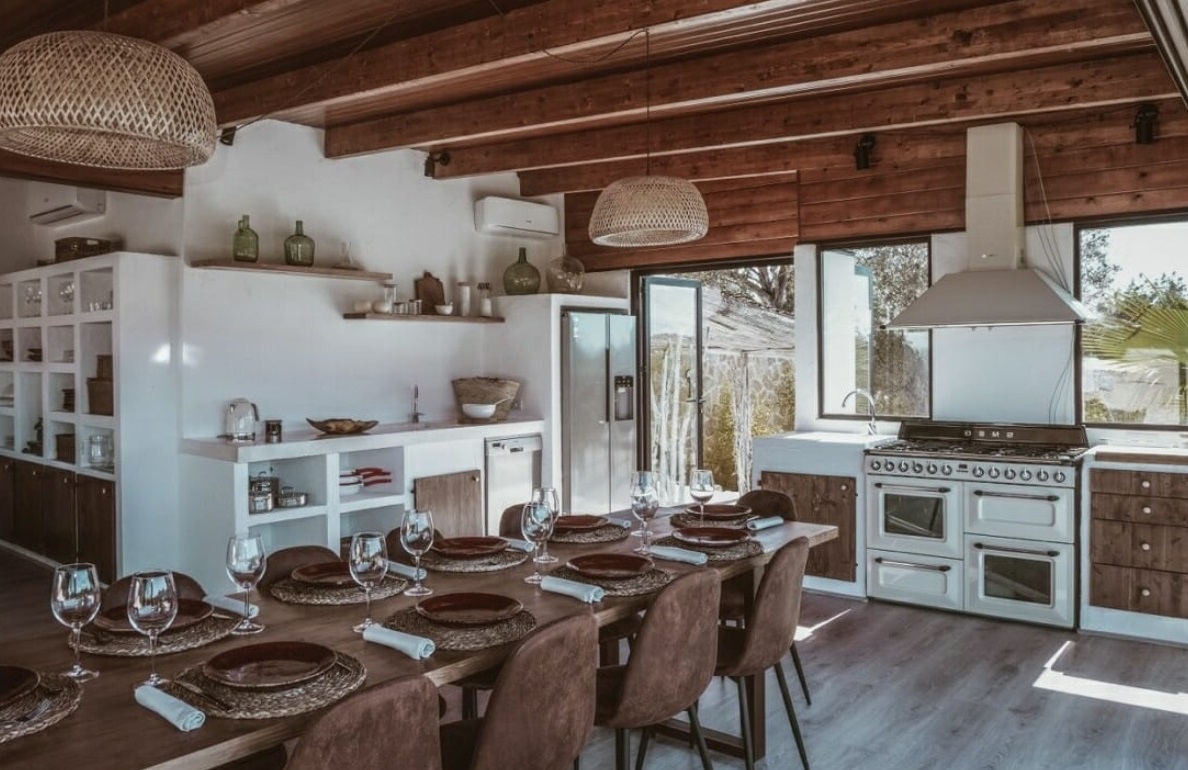
Last but not least, the floor is also important: wooden panels or tiles in matching colors give your Mediterranean kitchen a bold touch.
Last word
Mediterranean interior design can make any room unique. However, you risk a disharmonious appearance if you compromise and do not combine smaller accessories (e.g., textiles or tableware).
But don’t worry! Everything you need for authentic Mediterranean furniture is usually accessible in this country. However, you can check the local markets on your next holiday in Spain or Tuscany. An extraordinary “treasure” is often waiting here, which can ultimately increase the anticipation of your next vacation (or delicious meal…).
Mediterranean Architecture in General
The architectural style known as Mediterranean architecture is a result of the building materials used, the design characteristics, and the romanticized history of the region. Mediterranean houses have become a tradition in the coastal areas of the Mediterranean Sea, blending with the environment and nature around them. The form of the traditional Mediterranean house is a result of adaptation to the surrounding environmental and natural conditions.
The basic form of Mediterranean houses shows adjustments to environmental, climate, and geographical conditions in countries around the Mediterranean Sea, particularly in the southern European region. The geographical conditions, climate, and culture in each area around the Mediterranean greatly influence the formation of Mediterranean architecture. The style of buildings in the Mediterranean Sea stands out for the blend of Western and Eastern cultures and the distinctive style of buildings in coastal areas surrounded by islands, creating a warm, solid, but dynamic impression.
Mediterranean Architectural Style in Italy
The Mediterranean architectural style in the Southern European region, especially in Italy, is known for its beautiful buildings that are well-suited for the subtropical region experiencing four seasons in a year. Italy’s status as an archipelago with many beaches and seas has influenced the form of Mediterranean buildings, particularly in the cities of Venice and Sicily. The influence of Islamic architecture can be seen in the curved shapes adopted by Mediterranean buildings, which are a development of the geometric forms in Islamic architecture.
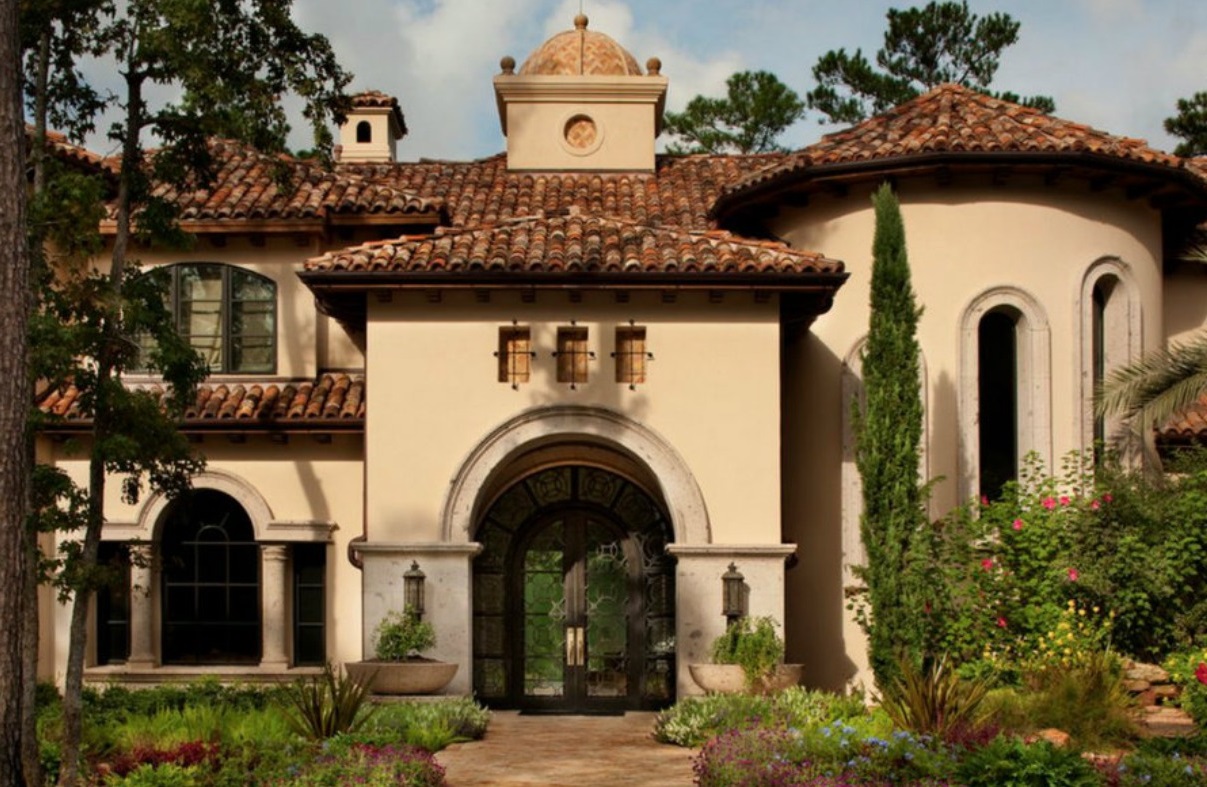
Traditional Mediterranean Architecture
Traditional Mediterranean houses, especially those in Italy, are considered vernacular architectural works designed and developed in the local community, taking into account natural factors, geographical conditions, and local culture, and influenced by neighboring countries in West Asia. Mediterranean architecture is also influenced by Roman and Greek architectural forms. In the early 15th century, a knight determined a building measurement rule based on the distance of his room. Armenopoulos’s Hexabiblos (mid-14th century) stipulates that protrusions such as balconies must provide a 15-foot clearance above the ground. Mediterranean society in the past adapted their homes to the natural and geographical conditions of the area and maximized the potential of nature by using natural stone and clay as building materials.
Traditional Mediterranean houses have a simple appearance, with geometric elements arranged to form a mass structure.
Mediterranean Interior Design Style for Kitchen, Living Room, Bathroom
Mediterranean Interior Design
Mediterranean interior design is a popular style worldwide, offering a unique and stylish look to a room while maintaining a clean and minimalist feel. From its history to design tips and decorating ideas, we will cover everything about Mediterranean interior design. If you are a homeowner looking to redesign your home, make sure you read till the end.
What is Mediterranean Style Interior Design?
Mediterranean Style Interior Design refers to the interior design style of Southern European countries such as Italy, Morocco, Greece, Spain, etc. This style is characterized by its fresh appearance, use of natural materials, and comfortable ambiance. It is a timeless style that appeals to those who appreciate minimalist and clean designs with a touch of luxury.
Due to the warm climates in most Mediterranean countries, this interior design style is best suited for homes that receive plenty of sunlight. Warm colors such as white, brown, and lime green are commonly used in Mediterranean interior design to brighten up the space and create the impression of a larger area.
History of Mediterranean Interior Design
The Mediterranean region encompasses countries surrounding the Mediterranean Sea, totaling about 22 countries with a temperate climate. The climate plays a significant role in shaping interior design styles to suit the warm and dry conditions of the region.
Although the Mediterranean countries have distinct cultures, the Mediterranean interior style shares similar elements across the region. However, each country has developed its own unique style over time. For example, Greek interiors often feature cobalt blue, while Italy is known for dark floors and country motifs.
In the 1920s, the Mediterranean interior design style gained popularity in the United States due to Spanish influence. Given the warm and sunny weather in cities like Florida and California, similar to the Mediterranean countries, this style became popular among interior designers. Mediterranean interior design represents a blend of luxury and practicality, contributing to its popularity in the US.
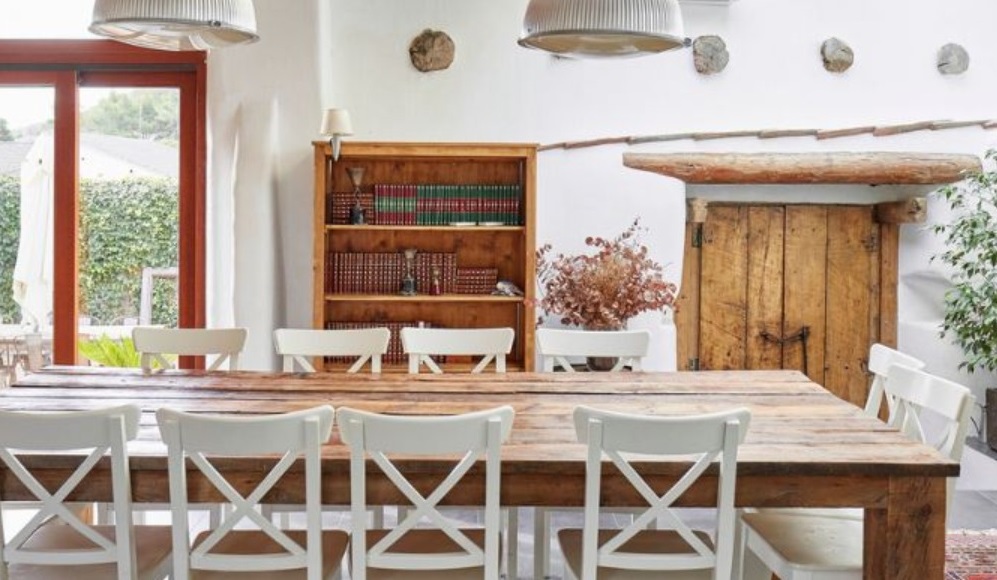
Key Elements of Mediterranean Decor
The key defining elements of Mediterranean home designs include:
- Sunlight
Given the temperate climate, Mediterranean designs make optimal use of sunlight, with large windows being an essential feature. White window frames are also used to create a clean look.
- Interior and Outdoor Design
Mediterranean design emphasizes both interior and outdoor spaces, including balconies and front yards, which are designed and furnished.
- Use of Natural Materials
Stone, terracotta, and wood are crucial components of Mediterranean architecture, used extensively throughout home designs. Wrought iron is another widely used component. These materials alone are sufficient to achieve the desired look.
- Regal yet Minimalist
Despite featuring stone walls and bright colors, Mediterranean design maintains a minimalist and straightforward style, avoiding an excessive number of elements to create a refined look.
Types of Mediterranean Interior Design
Currently, there are four main Mediterranean interior styles:
- Greek
Greek style incorporates a lot of blue and turquoise, often using mosaic tiles and floors. Iron furniture and brightly colored carpets with intricate designs are also characteristic of this style.
- Spanish Revival
Spanish and Moroccan Revival styles share similarities in their design. Similar to the Greek style, Spanish design features the use of blue, mainly in furniture, as well as terracotta tiles and pots. The overall look is simple, functional, and minimalist.
- Italian
Italian design stands out with rounded arches, overhead beams, wood floors, and stone structures.
- Modern Mediterranean
This style combines traditional Mediterranean revival design with modern architecture, incorporating new and modern techniques while retaining traditional finishes.
Even though this is the most popular type of interior design, each country in Southern Europe possesses its own distinct and unique style. Therefore, if you can incorporate the culture of a specific country into your style, this design has no strict rules, allowing you to customize it according to your preferences and requirements. The previously mentioned types are just meant to introduce you to different design styles.
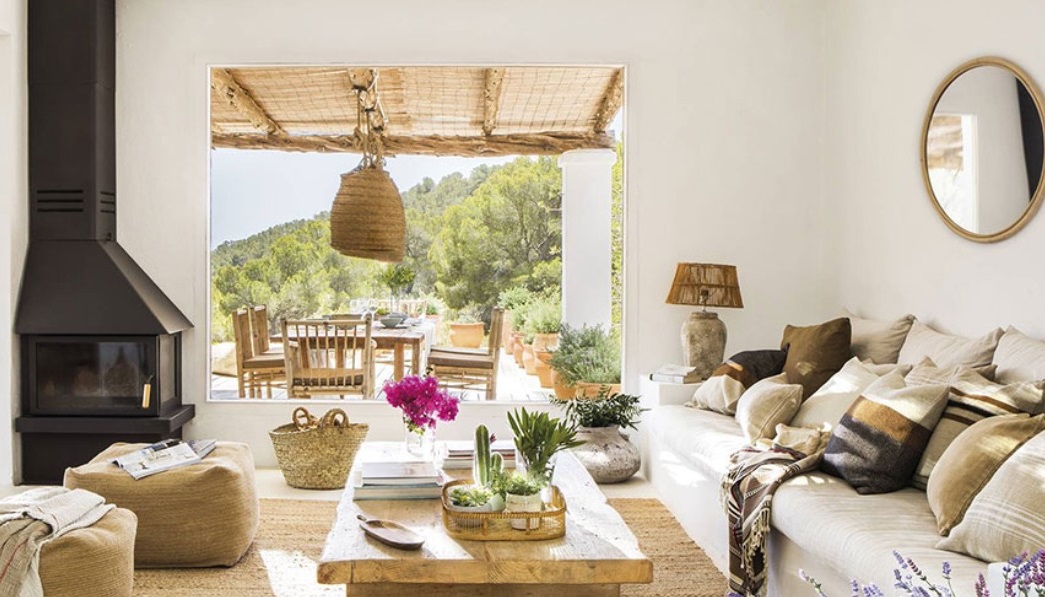
10 Ideas for Decorating with Mediterranean Style Interior Design
The Mediterranean style is uncomplicated and can be easily replicated if you keep a few things in mind. The following suggestions will assist you in creating the perfect design:
- Welcome sunlight into the room
Ensure that the room receives maximum sunlight exposure. You can even add extra windows for this purpose.
- Utilize plenty of white
White helps to illuminate the room and reflects sunlight effectively, creating a bright space. Using white for walls, furniture, and ceilings can effectively give the room a Mediterranean feel.
- Establish an accent wall
An accent wall within a space with a distinct color or texture can help define the area and give it more character. Depending on your preference, you can opt for a blue textured wall or a stone wall to create an accent wall.
- Introduce an arch
Incorporating a rounded arch near doorways and other corners can be an excellent way to infuse Italian style. The arch also creates a clear separation in spaces.
- Keep it simple
Elegant and luxurious Mediterranean interiors often appear simple yet functional. Due to the prevalence of white, maintaining the house can be challenging. Therefore, it is essential to prioritize functionality over design.
- Be adventurous
Despite its unique style, there are numerous options available. So, don’t be afraid to experiment and try them all.
- Incorporate natural elements
Elements such as stone, terracotta, wood, and marble should be extensively used.
- Furnish thoughtfully
Furniture is also crucial. Incorporate unique and interesting elements into your furniture. Large sofas, armchairs, chandeliers, etc., can help bring the entire look together.
- Select the right accessories
Although accessories may seem insignificant, they can significantly enhance or detract from the overall look. Utilize large carpets, rugs, and stylish curtains to add the finishing touch to your home. Intricately designed rugs hold significant cultural value in Southern Europe. Invest in high-quality items. Tall, lush, and vibrant indoor plants can also serve as excellent accessories. Plants such as Areca Palm, Lemon, ZZ, and Sansevieria are great choices.
- Establish a color scheme
While the Mediterranean style predominantly features bright, warm colors, there are also numerous options in muted colors. However, it is crucial to adhere to a single color palette for the room. Mixing palettes will not create a cohesive look and will make the house appear incomplete.
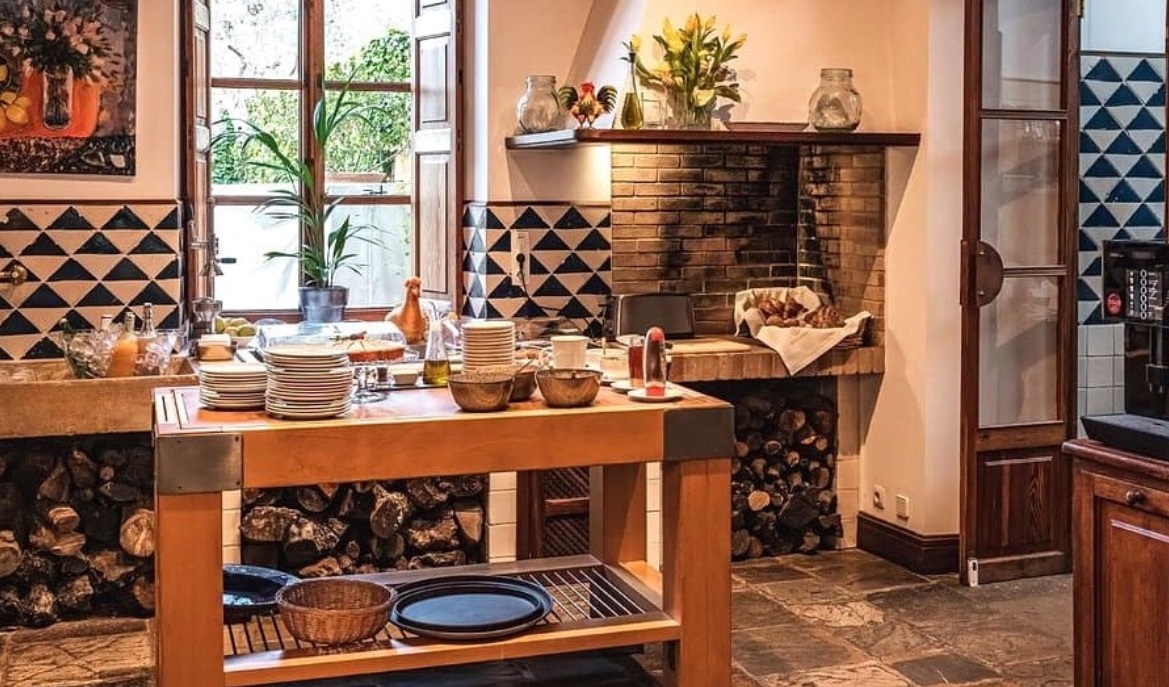
Mediterranean Style for the Kitchen
The kitchen is a vital component of a Mediterranean-style home. Spacious kitchens with kitchen islands and special dining tables are common in this style. Therefore, if space permits, invest in a generous kitchen. However, the Mediterranean style can also be applied to smaller kitchens.
A comfortable kitchen will undoubtedly make you feel at home, right? Besides serving as a cooking space, the kitchen also functions as a place for interacting with all family members. To achieve a versatile kitchen ambiance that is warm, cozy, and enhances the enjoyment of cooking activities, consider creating a kitchen with a Mediterranean concept.
Warm wooden cabinets are an excellent way to quickly add a Mediterranean vibe to your kitchen. If wooden cabinets aren’t feasible, you can opt for stone-textured tiles and marble kitchen countertops to achieve a rustic look. Hand-painted tiles in blue and other vibrant color schemes are also a traditional feature of Greek interiors. Incorporating these elements will help add color and break up any monotony in the kitchen.
Introducing lights and bold lighting can add character and create a cozier and warmer ambiance. Use yellow lights and candles to highlight the unique elements of your kitchen effectively.
You can also decorate the ceilings to achieve an elegant look. Wooden ceiling designs, beams, and patterns are commonly found in Mediterranean kitchens. These designs help infuse warmth into the room and distinguish the kitchen from the rest of the house.
When designing your kitchen, consider your specific needs and integrate modern elements. Make space for modern technology devices that you may use in the kitchen to keep it functional. For instance, if you’re a family of three, investing in a large dining room purely for aesthetics may not be a prudent decision. Customize the furniture to suit your needs and adjust the design style accordingly.
In general, Mediterranean-themed architectural designs feature rich color nuances and create a pleasant and relaxed impression. This style is a romantic architectural art typical of countries in the southern coastal areas of Europe. Mediterranean design is a popular building style in various countries due to its beautiful appearance and ability to create a comfortable atmosphere.
Brightly Colored Cabinets
Opt for white kitchen cabinets with yellow fronts and red handles for a vibrant touch.
Patterned Tiles
Enhance the Mediterranean feel by swapping plain colored kitchen tiles for eclectic black, blue, or white tiles. Avoid using plain colored tiles as they may appear ordinary.
Unique Antique Table
To create a Mediterranean-style kitchen, consider incorporating a traditional Spanish table with unique details, such as spiral table legs or intricate table body designs.
Ethnic Motif Pillowcases
Adorn the kitchen windows with a minimalist sofa featuring pillowcases adorned with fish, woven, or ikat motifs made of linen.
Patterned Tableware
Replace floral patterned tableware with abstract motifs such as tribal or mosaic to achieve the eclectic mix of modern and classic nuances typical of Mediterranean style.
Black and Gold Accents
Incorporating black and gold accents, such as cookie or candy jars, dining table lamps, chairs, and tissue holders, will further accentuate the Mediterranean style in your kitchen.
